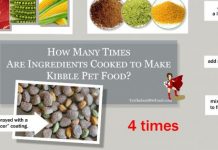Welcoming a new puppy into your home is an exciting and joyous occasion, filled with playful moments and the beginning of a lifelong bond. As a devoted pet parent, you naturally want to provide the best care possible, ensuring your furry friend grows up healthy and happy. However, navigating the world of puppy care can be a bit overwhelming, especially when it comes to their diet. Feeding your puppy may seem straightforward, but there are common pitfalls that many new owners inadvertently fall into. These mistakes can have lasting effects on your puppy’s health and development. In this article, we’ll explore some of the most frequent puppy feeding errors and offer practical advice to help you nurture your puppy with confidence and love. Whether you’re a first-time puppy parent or a seasoned dog lover, understanding these feeding nuances will set your little one on the path to a vibrant and thriving life.
Choosing the Right Puppy Food for Optimal Health
When it comes to nourishing your little furball, the quality of ingredients in their food plays a pivotal role in their growth and development. Always look for puppy food that lists a high-quality source of protein, such as chicken or fish, as the first ingredient. Avoid foods with excessive fillers like corn and soy, which offer little nutritional value and can lead to digestive issues. Additionally, ensure the food contains essential fatty acids like omega-3 and omega-6, which are crucial for a shiny coat and brain development.
- Protein Source: Ensure the first ingredient is a quality protein.
- Avoid Fillers: Steer clear of corn and soy fillers.
- Essential Fatty Acids: Look for omega-3 and omega-6.
Another critical aspect is the nutritional balance tailored for puppies. Puppy-specific formulas are enriched with the right blend of vitamins and minerals necessary for their developing bodies. Feeding adult dog food to a puppy can deprive them of vital nutrients, impacting their immune system and overall health. Choose brands that adhere to AAFCO standards for puppy nutrition, ensuring your little one gets the complete and balanced diet they need.

Avoiding Overfeeding and Understanding Portion Sizes
One common mistake new puppy owners make is serving meals that are too large, leading to overfeeding and potential health issues. Puppies have small stomachs, and it’s crucial to understand the appropriate portion sizes for their age, breed, and activity level. Consult your veterinarian to get a precise feeding plan tailored to your puppy’s needs. Overfeeding can result in obesity, which is linked to numerous health problems like joint pain and heart disease. Remember, it’s not just about filling the bowl; it’s about filling it right.
- Follow feeding guidelines: Check the packaging of your puppy’s food for recommended serving sizes based on weight and age.
- Observe your puppy’s growth: Adjust portions as they grow. Rapid growth is not always healthy and might require changes in their diet.
- Use measuring tools: Invest in a good measuring cup or kitchen scale to ensure you’re not overestimating portions.
- Monitor treats: Treats should only make up about 10% of your puppy’s daily caloric intake.
By keeping a close eye on portion sizes and making adjustments as needed, you can help your puppy grow into a healthy and happy adult dog. A little attention to detail now can prevent a host of issues down the line, making for a joyful life together.

Recognizing Harmful Ingredients and Safe Alternatives
When it comes to feeding your puppy, understanding the ingredients in their food is crucial for their health and development. Some ingredients, while common, can be harmful to your furry friend. For instance, certain preservatives and artificial colors can cause allergies or other health issues. It’s essential to be aware of these ingredients and opt for safer alternatives. Here are some key ingredients to avoid and their healthier counterparts:
- Artificial Preservatives: Chemicals like BHA, BHT, and ethoxyquin are often used to extend shelf life but can lead to long-term health problems. Instead, look for foods preserved with natural antioxidants like vitamin E (mixed tocopherols) and vitamin C.
- Fillers: Ingredients such as corn, wheat, and soy are used to bulk up food but offer little nutritional value and can cause allergies. Choose products with whole grains like brown rice or oats, which are more digestible and nutritious.
- By-products: Meat by-products are lower-quality protein sources that may not provide the necessary nutrients. Opt for foods that list specific meat sources, like chicken or lamb, as the primary ingredient.
- Artificial Colors and Flavors: These additives can trigger allergic reactions and are unnecessary for your puppy’s diet. Seek out foods that use natural flavors and colors derived from real ingredients.
By carefully selecting your puppy’s food and avoiding these harmful ingredients, you can help ensure they grow up healthy and strong. Always read labels and choose high-quality, natural options to provide your puppy with the best nutrition possible.

Establishing a Consistent Feeding Schedule for Your Puppy
One of the most crucial aspects of nurturing a healthy puppy is establishing a feeding routine that aligns with their developmental needs. A consistent schedule not only supports physical growth but also promotes good behavior and digestion. Here are some key points to consider when setting up a feeding timetable:
- Age Matters: Puppies have different nutritional needs at various stages of their growth. Typically, young puppies need to be fed three to four times a day. As they grow, this can gradually be reduced to two meals a day.
- Portion Control: Overfeeding can lead to obesity and related health issues. Always follow the guidelines provided by your vet or the food manufacturer, adjusting based on your puppy’s size and activity level.
- Regular Timing: Try to feed your puppy at the same times every day. This predictability helps regulate their metabolism and creates a sense of security, reducing anxiety around mealtime.
- Monitoring Health: Regularly check your puppy’s weight and body condition. Any sudden changes might require adjustments in their diet or feeding schedule.
Implementing a structured feeding plan with these principles can significantly enhance your puppy’s overall well-being, setting a solid foundation for a healthy life ahead.
















